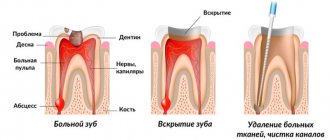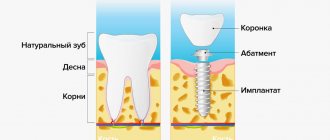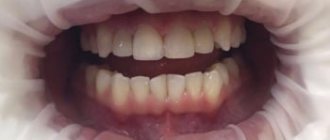- Why a temporary filling is placed: types of material
- Why does a tooth with a temporary filling hurt: the main reasons
- Standard activities after installation of the material
- Temporary filling hurts when pressed: how to cope with the disease
Many patients complain to dentists that their tooth hurts under a temporary filling.
For the first 2-3 days, a slight aching pain is considered normal and does not cause cause for concern or panic. It is associated with the active influence of drugs on the nerve endings of the molar or premolar. If the temporary filling hurts very strongly and for a long time when pressed, it is recommended to make an appointment with a specialist earlier than the specified date. Dentists at the reliable A-Medic clinic will conduct a thorough examination and prescribe a diagnostic examination to find out what exactly is causing the pain. All people are scared that they have had a temporary filling installed and their tooth hurts, but most often there is no reason to worry.
Why a temporary filling is placed: types of material
Non-permanent filling is a mandatory measure in the treatment of complicated carious lesions and root canal inflammation. It is required for medicinal treatment of an inflamed molar or premolar. It is entrusted with the protective function of the treated cavity from food ingress. Also, it prevents the medical pad from falling out.
The composition of such material differs significantly from a permanent filling. It can be made from water-insoluble or plastic components. The choice of the most suitable material directly depends on the condition of the molar or premolar and the purpose of the installation. Among the most common materials are:
- sympath. It can be of different shades - white (for filling non-pulp teeth) or light pink. The mass does not provoke irritation and other allergic reactions;
- dentin paste. It reliably protects the tooth from staining with amalgams and is characterized by water-repellent properties. The paste hardens in 100-120 minutes;
- zinc polyacrylate cement. It is characterized by good biocompatibility with tissues and high strength. The material is used for fixing prostheses (crowns) or filling (both permanent and baby teeth);
- Vinoxol. It is characterized by reliability and durability, capable of maintaining integrity for up to 4-5 months. The drug has antiseptic properties, which allows you to disinfect the tooth cavity. It hardens in 3-4 hours.
There are situations when the carious lesion did not have time to reach the nerve. In such cases, the molar or premolar is not depulped, but temporary material is installed. This is necessary for diagnosis to see whether the tooth will become sensitive or not. With the help of these measures, it is possible to completely preserve a molar or premolar (without removing the nerve) if the patient does not experience pain. If a pronounced reaction occurs (if the temporary filling hurts), the dentist will remove the nerve after placing a filling with arsenic.
Often, non-permanent filling is resorted to during prosthetics. This allows you to protect the molar or premolar from pathogenic microorganisms. The wearing period is individual and directly depends on the type of material and the reason why filling was required. It is installed by the attending dentist. On average, after 7-10, specialists replace it with a permanent filling. Sometimes, after applying a temporary filling, a tooth hurts; let’s figure out what could cause this phenomenon.
Why does a tooth with a temporary filling hurt: the main reasons
Often, patients with a temporary filling have a toothache when pressed. In some cases, such a reaction is considered normal. The attending physician will be able to answer for sure why a tooth hurts after a temporary filling after examining the oral cavity and conducting a diagnostic examination. Let's take a closer look at the main reasons for the appearance of pronounced discomfort sensations:
- Impact of the drug. If a tooth hurts with a temporary filling and medication, then most often the source of discomfort is its effect on the tissue. You should contact a specialist if the pain is pronounced and reduces the quality of life.
- Unfinished therapy. Often, after the pain has subsided, a person decides to stop therapy and does not come to an appointment to replace it with a permanent material. Temporary material is not intended to be worn for several years, so sooner or later it will fall out. It is recommended to replace at the appointed time.
- Allergic reaction to cementitious agent. If a tooth with a temporary filling aches and hurts a lot, the reason may lie in an allergic reaction. In such a situation, it would be more advisable to replace it with another cementing agent (depending on the period of wear).
- Lack of material. There is a high probability that it fell out while drinking or eating food, so external factors (irritants) come into direct contact with the soft tissues. An infection could have entered the tooth cavity, causing an inflammatory reaction.
- Prolonged wearing of the cementing agent (longer than the prescribed period). The material is quite fragile; when worn for a long time, it begins to lose its tightness, allowing pathogenic microorganisms (bacteria) to enter the cavity of the molar or premolar.
The biggest cause for concern is discomfort after installation of permanent material. This is an alarming signal that may indicate incorrect installation, untreated pathology, or emerging complications. In this situation, you need to make an appointment with a specialist to determine the main source of pain.
Discomfort and inconvenience after installation of a filling
Immediately after a filling, the cause of discomfort in the mouth may be the lack of treatment before the filling is placed, and having a healthy tooth can create an unusual feeling of something new.
discomfort conditions of a filled tooth are a reason to urgently consult a doctor
- Foreign body sensation requires diagnosis to determine the origin of the discomfort. If you ignore such a symptom, there is a possibility of developing more complex inflammatory processes.
- A feeling of roughness and scratching indicates insufficient polishing of the filling. The defect is quickly eliminated with a second visit to the doctor and additional polishing to a comfortable state.
- An incorrect bite indicates an incorrect formation of the shape of the filling, which is measured in fractions of millimeters. The reason for this situation is the fact that anesthesia, which continues for some time after the filling procedure, does not make it possible to fully feel the shape of the tooth. Numbness of the jaw under the influence of anesthetics makes it difficult to report the presence of discomfort in the dentist’s office immediately after the filling is installed. The shape of the filling is quickly corrected by filing during a second visit to the doctor.
- A tightening tension in the jaw, a feeling of pressure inside the filled tooth, and discomfort when closing the teeth are created by an oversized filling. This is caused by increased pressure on the tooth walls and nerve endings. Possible consequences range from microdestruction of the dental wall to bacterial inflammation, from malocclusion to diseases of the temporomandibular joint.
- An incorrectly shaped filling can also create additional trauma to the oral mucosa when wearing orthopedic structures.
- Some time after the filling is installed, an increased reaction to irritants even without them (sour, cold, etc.) goes away with the correct selection of paste and other means. A sensitive reaction can be triggered by overdrying of the dentin during filling or loss of tightness of the filling material. To get rid of unpleasant sensations, the intervention of a doctor is necessary.
- Uncomfortable sensations during eating and the entry of food particles into the interdental spaces require the restoration of the interdental contact point, which determines the anatomical correspondence of the filled tooth with the rest of the teeth.
- An allergy to the components of the filling material is sometimes accompanied by bitterness in the mouth, pain, and skin reactions: itching, rash. In such a situation, the filling is replaced with a material that does not cause an individual reaction.
Dental specialists at Die Hard will individually consider the causes of discomfort after installing a filling and eliminate them, providing you with the comfort of healthy teeth. Dentistry in Moscow will cope with even the most complex inconveniences that appear after filling.
Standard activities after installation of the material
Do not drink or eat until the material has completely hardened, as it may crack or fall out completely. Also, food can get into the cavity of a molar or premolar. After a non-permanent filling, it is not recommended to eat soft food for the first 2-3 hours, and hard food for 10-12 hours. This will avoid a number of negative consequences. When chewing solid food in the future, you should use less of the side on which the filling was performed.
While wearing the material, hygiene rules must not be neglected. You should brush your teeth twice a day, and after eating, rinse your mouth with antiseptic solutions and floss. If the temporary material is installed for several months, it is recommended to use a brush with softer bristles during this period. To avoid possible complications, the material is removed on a strictly designated day.
Temporary filling hurts when pressed: how to cope with the disease
People often ask the question: “if you have a temporary filling installed and your tooth hurts, what should you do?” When a tooth hurts under a temporary filling, this is a normal condition, do not panic. If the dentist said that there is no cause for concern, you should be patient and wait out the unpleasant symptom. When a temporary filling causes severe pain in a tooth, and you run out of strength to endure the pain, you can use the following recommendations:
- rinse your mouth with antiseptic and soothing solutions. You can prepare them yourself at home from natural ingredients. For example, chamomile and sage are poured with boiling water and the resulting product is used to rinse the mouth;
- do not allow food and drinks (mainly hot or cold) to come into contact with the treated tooth;
- take a painkiller (analgesic). “Nise” and “Ketorol” give good results;
- make lotions with valerian tincture. A moistened cotton swab of valerian is applied to the painful area, the gum near the tooth. This will temporarily relieve the irritation.
If a tooth hurts after installing a temporary filling and swelling or redness of the soft tissue appears, this may indicate the presence of an inflammatory process or the appearance of pus. In such a situation, you should re-make an appointment with a dentist-therapist. The A-Medic clinic employs qualified specialists with extensive experience. To make an appointment, just fill out the standard form on the official website of the clinic (indicating your full name and contact number). Prices are affordable, and consultation with a dentist is completely free.
Non-dangerous pain
Natural post-filling pain
it is considered to be one that occurred after treatment and went away on its own after a relatively short period of time. The nature of this pain is aching and mild, which can sometimes intensify with:
- pressing (strong brushing of teeth, biting);
- alternating hot and cold dishes;
- severe stress;
- hypothermia.
The recovery period varies and depends on the type of treatment:
- if the doctor removed carious formations, the pain may persist, on average, from 3 to 5 days;
- after filling the canals, the pain disappears, as a rule, after a couple of weeks, sometimes after a month;
- after depulpation (removal of the neurovascular bundle inside the canal), a period of one to two months becomes the norm.
The general rule is: the more serious and deeper the dental intervention, the longer the rehabilitation period.
Pain under a temporary filling
is not considered dangerous if it occurs when pressure is applied to a tooth. If the sensations are very painful, you need to consult a doctor again for additional examination.
Refined diagnostics will allow you to get rid of shortcomings when replacing a temporary filling with a permanent one.
When treating a tooth, it is important to choose the correct filling size










